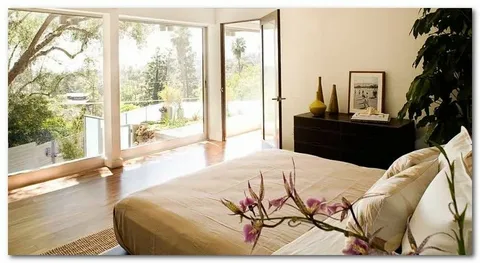I. Introduction
In the hustle and bustle of daily life, having a serene and tranquil space to retreat to is essential for overall well-being. Transforming your bedroom into a Zen-inspired retreat can provide a peaceful sanctuary where you can unwind, relax, and rejuvenate. In this guide, we’ll explore the elements and steps to create a Zen-inspired bedroom that promotes harmony and tranquility.
II. Simplify and Declutter
Minimalistic Approach: Embrace a minimalistic approach by decluttering your bedroom. Remove unnecessary furniture and decor, keeping only the essentials. A clutter-free environment fosters a sense of calm and order.
Storage Solutions: Invest in storage solutions to keep belongings organized and out of sight. Opt for furniture with built-in storage, such as under-bed drawers or wall-mounted shelves, to maintain a clean and open space.
III. Natural Elements and Colors
Neutral Color Palette: Choose a neutral color palette dominated by earthy tones such as soft whites, beige, and muted greens. These colors evoke a connection to nature and contribute to a serene atmosphere.
Natural Materials: Incorporate natural materials like wood, bamboo, and stone into your bedroom decor. Choose furniture and accessories with natural textures to create a grounding and harmonious environment.
IV. Comfortable and Cozy Bedding
High-Quality Bedding: Invest in high-quality, comfortable bedding to enhance the coziness of your bedroom retreat. Opt for soft, breathable fabrics such as cotton or linen for sheets and duvet covers.
Plush Pillows and Throws: Add plush pillows and throws to your bed to create a welcoming and inviting space. Choose natural fabrics and muted colors to maintain a soothing aesthetic.
V. Ambient Lighting
Soft and Warm Lighting: Opt for soft and warm lighting to create a tranquil ambiance. Consider using table lamps, wall sconces, or string lights with dimmers to control the intensity of light in the room.
Natural Light Enhancement: Maximize natural light during the day by choosing sheer curtains or blinds that allow sunlight to filter through. Natural light promotes a sense of openness and positivity.
VI. Mindful Decor Choices
Symbolic Decor: Incorporate symbolic decor that holds personal meaning and aligns with Zen principles. Items such as a Buddha statue, bonsai tree, or simple artwork can add a touch of mindfulness to the space.
Artwork and Wall Decor: Choose artwork that reflects tranquility and simplicity. Consider nature-inspired prints, serene landscapes, or abstract art with calming colors. Use wall decor sparingly to maintain a sense of spaciousness.
VII. Feng Shui Principles
Balanced Arrangement: Apply Feng Shui principles to create a balanced arrangement in your bedroom. Position the bed so it has a clear view of the door, avoid clutter under the bed, and incorporate elements of the five Feng Shui elements—wood, fire, earth, metal, and water.
Open Flow of Energy: Ensure a harmonious flow of energy (chi) by keeping pathways clear and avoiding furniture blocking doorways. Allow energy to circulate freely through the room for a positive and peaceful environment.
VIII. Personalized Meditation Space
Quiet Corner for Reflection: Designate a quiet corner or alcove for meditation and reflection. Place a comfortable cushion or meditation chair, and decorate the space with elements that promote serenity, such as candles or incense.
Mindful Practices: Incorporate mindful practices into your daily routine, such as meditation or deep breathing exercises. Creating a dedicated space for these activities reinforces the Zen-inspired atmosphere of your bedroom.
IX. Aromatherapy and Scents
Natural Scents: Introduce natural scents to your bedroom through aromatherapy. Use essential oils like lavender, eucalyptus, or chamomile in a diffuser to promote relaxation and create a soothing atmosphere.
Fresh Air and Ventilation: Ensure proper ventilation to keep the air in your bedroom fresh and clean. Open windows regularly to allow natural airflow and connect with the outdoor environment.
X. Conclusion
Transforming your bedroom into a Zen-inspired retreat is a holistic approach to fostering peace and tranquility in your daily life. By incorporating natural elements, simplifying your space, and embracing mindful practices, you can create a sanctuary that promotes relaxation, restful sleep, and overall well-being.
FAQs Landscaping with Drought-Tolerant Plants
I. Introduction
In the face of changing climate patterns and increasing water scarcity, landscaping with drought-tolerant plants has become a smart and sustainable choice for homeowners. Not only do these plants thrive in arid conditions, but they also reduce water consumption and maintenance efforts. This guide will explore the benefits of drought-tolerant landscaping and offer practical tips for incorporating these resilient plants into your outdoor space.
II. Benefits of Drought-Tolerant Landscaping
Water Conservation: The primary advantage of drought-tolerant landscaping is water conservation. These plants are adapted to survive with minimal water, making them an eco-friendly choice in regions where water resources are limited or subject to restrictions.
Lower Maintenance: Drought-tolerant plants typically require less maintenance than traditional landscaping. Their ability to thrive in arid conditions means less frequent watering, reduced need for fertilizers, and minimal pest control measures.
Sustainability: By choosing plants that are well-suited to the local climate, you contribute to the overall sustainability of your landscape. Drought-tolerant landscaping promotes biodiversity and supports the local ecosystem by providing habitats for native wildlife.
Cost Savings: Reduced water usage and lower maintenance needs translate to cost savings for homeowners. As water bills decrease and the need for landscaping services diminishes, you can enjoy a beautiful and sustainable outdoor space without breaking the bank.
III. Selecting Drought-Tolerant Plants
Native Plants: Consider incorporating native plants into your landscape design. These plants have evolved to thrive in the local climate and soil conditions, making them naturally resistant to drought.
Succulents and Cacti: Succulents and cacti are iconic choices for drought-tolerant landscaping. Their unique shapes and textures add visual interest to your garden while requiring minimal water.
Grasses and Groundcovers: Opt for drought-tolerant grasses and groundcovers to create a lush, low-maintenance lawn alternative. Buffalo grass, blue fescue, and creeping thyme are excellent choices.
Perennials and Shrubs: Choose perennials and shrubs that are known for their drought resistance. Lavender, rosemary, and yarrow are not only hardy but also bring delightful fragrances to your garden.
IV. Designing a Drought-Tolerant Landscape
Grouping Plants by Water Needs: When planning your landscape, group plants with similar water requirements together. This allows for more efficient irrigation, ensuring that each plant receives the appropriate amount of water without overwatering others.
Mulching: Apply a layer of mulch around plants to conserve soil moisture. Mulch acts as a barrier, preventing water evaporation and suppressing weed growth. Use organic mulches like bark chips or straw for added benefits.
Efficient Irrigation Systems: Invest in efficient irrigation systems such as drip irrigation or soaker hoses. These methods deliver water directly to the plant’s root zone, minimizing wastage and maximizing water absorption.
Rainwater Harvesting: Consider implementing rainwater harvesting systems to collect and store rainwater for later use. This sustainable practice provides an additional water source for your landscape during dry periods.
V. Maintenance Tips
Pruning and Deadheading: Regular pruning and deadheading help maintain the health and appearance of your drought-tolerant plants. Remove dead or damaged growth to encourage new growth and flowering.
Soil Amendments: Improve soil quality by incorporating organic matter like compost. Well-amended soil retains moisture more effectively, supporting the water-retention capabilities of drought-tolerant plants.
Monitor Plant Health: Keep an eye on the health of your plants. Look for signs of stress, pests, or diseases. Early detection allows for prompt intervention, ensuring the longevity of your drought-tolerant landscape.
VI. Conclusion
Landscaping with drought-tolerant plants is a sustainable and visually appealing choice for homeowners seeking resilient outdoor spaces. By selecting the right plants, designing thoughtfully, and implementing efficient irrigation, you can create a landscape that not only conserves water but also thrives in the face of changing environmental conditions.
FAQs
Q: Can I have a colorful garden with drought-tolerant plants? A: Absolutely! Many drought-tolerant plants offer vibrant colors and diverse textures. Explore options such as lantana, salvia, and penstemon for a colorful and water-wise garden.
Q: Can I use drought-tolerant plants in regions with occasional heavy rainfall? A: Yes, many drought-tolerant plants are adaptable to different conditions. However, proper drainage is essential to prevent waterlogged soil, especially in periods of heavy rainfall.
Q: Are there specific landscaping styles that work well with drought-tolerant plants? A: Drought-tolerant plants can be incorporated into various landscaping styles, from Mediterranean and desert-inspired designs to modern and eclectic layouts. Their versatility allows for creative and personalized landscape designs.
Q: How can I attract pollinators to my drought-tolerant garden? A: Choose flowering plants that attract pollinators, such as bees and butterflies. Lavender, coneflowers, and salvia are popular choices. Providing a water source, like a small birdbath, can also attract birds to your garden.
Q: Can I use mulch in a xeriscape garden? A: Yes, mulch is a beneficial addition to xeriscape gardens. It helps conserve soil moisture, suppress weeds, and regulate soil temperature. Choose organic mulches that break down over time, contributing to soil health.
Q: Can I incorporate color into a Zen-inspired bedroom? A: Yes, you can incorporate muted and natural tones into a Zen-inspired bedroom. Soft greens, blues, and earthy neutrals can add subtle touches of color while maintaining a calming atmosphere.
Q: How can I create a Zen-inspired workspace within the bedroom? A: Designate a specific area for work within your bedroom, keeping it separate from the relaxation zone. Use minimalistic furniture, natural materials, and soft lighting to maintain a peaceful work environment.
Q: Is it necessary to follow Feng Shui principles strictly? A: While strict adherence to Feng Shui principles is not necessary, incorporating basic principles can enhance the overall harmony and balance in your bedroom. Adjustments can be made based on personal preferences and room layout.
Q: Can I use scented candles instead of a diffuser for aromatherapy? A: Yes, scented candles can be used for aromatherapy in a Zen-inspired bedroom. Opt for candles with natural, calming scents and place them strategically to enhance the overall ambiance.
Q: How can I make a small bedroom feel more Zen-like? A: In a small bedroom, focus on simplicity and minimalism. Choose furniture with clean lines, use neutral colors, and maximize natural light to create a sense of openness and tranquility.
Source Links:




